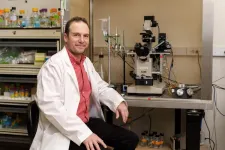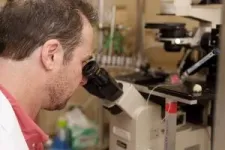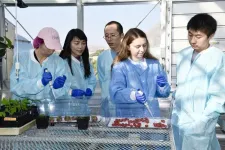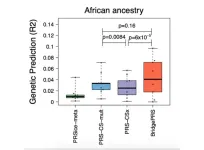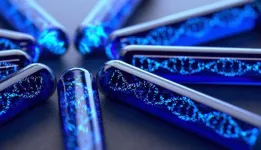Brine shrimp of the genus Artemia are small crustaceans that can thrive in environments where sodium concentrations are as high as 25% (more than eight times typical ocean sea water). Also known by the household pet trademark ‘sea monkeys,’ these animals are abundant in inland salt lakes where brine-fly larvae are the only other animals known to exist.
The mechanisms which permit brine shrimp to tolerate some of the harshest environments are only partially understood. Previously known adaptive features include a tight protective layer (integument) to avoid water loss and the increased extrusion of sodium (Na+) and chloride (Cl-) ions through specialized salt glands in the neck of larvae or in the swimming appendages of adults.
The salt gland lining is an ion-transport tissue in which the transport of most ions is powered by the sodium-potassium ATPase (NKA), an essential protein pump found in all animals and formed by an alpha (α) and a beta (β) subunit. Most known NKA variants transport three Na+ ions out of the cell in exchange for importing two potassium (K+) ions. The Na+ gradient built by the NKA is then used by other proteins in the cell membrane to transport other substances.
One brine shrimp NKA α subunit variant drastically increases abundance as salinity rises. The upregulation is extreme at salinities where not even brine fly larvae (which lack a special α subunit variant) can survive. To better understand the advantages this variant provides to the ability of brine shrimp to survive in extreme salinity, a research team led by Pablo Artigas, Ph.D., from the Texas Tech University Health Sciences Center (TTUHSC) School of Medicine’s Department of Cell Physiology and Molecular Biophysics (CPMB) and Center for Membrane Protein Research, examined the changes induced by salinity and the structure and function of the upregulated NKA variant.
The research team included Artigas’ CPMB and Center for Membrane Protein Research laboratory members Dylan J. Meyer, Ph.D., Victoria C. Young, Ph.D., Kerri Spontarelli and Jessica Eastman; and collaborators Evan Strandquist and Craig Gatto, Ph.D., from Illinois State University; Huan Rui, Ph.D., and Benoit Roux, Ph.D., from the University of Chicago; Matthew A. Birk, Ph.D., from St. Francis University (Pennsylvania); and Hanayo Nakanishi, Ph.D., and Kazuhiro Abe, Ph.D., from Nagoya (Japan) University.
Their study (“A Na pump with reduced stoichiometry is upregulated by brine shrimp in extreme salinities”) was published in December by Proceedings of the National Academy of Sciences (PNAS). The research was funded by a grant from the National Science Foundation.
Prior to embarking on structure function studies, the researchers discovered that brine shrimp have three α variants (instead of the two previously known) and two β variants (instead of one). The α subunit contains most of the protein components necessary for NKA function, while β is necessary for the NKA to reach the plasma membrane, where the NKA is localized for proper function. The upregulated NKA subunit is called α2KK because it has two amino acid substitutions, where lysine (a positively charged residue indicated by the single-letter code K) replaces asparagine (a polar, neutral residue) in the region where the sodium and potassium ions bind during the transport process.
The research team was able to solve the structure of the α2KK, which revealed that the two NKA-alpha2KK lysines were situated in a manner that could allow them to alter the number of Na+ and K+ ions the pump transports per cycle. The team then showed that the double-lysine containing NKA behaves like α2KK, and then demonstrated that these lysine-containing NKA variants transport with a different stoichiometry: two Na+ for one K+ instead of the Na+ for two K+ in each cycle. Stoichiometry is the calculation of the ratio between reactants and products during a chemical reaction or process.
This unique stoichiometry means that this special NKA variant uses more energy than canonical (commonly recognized) NKAs to transport Na+ and K+. Artigas said one way to envision why this is important is to think of the gradient as the height, and the sodium ions as the bricks that need to be lifted to that height. You may be able to lift three bricks at once from the floor, but may only be able to lift them a few inches. If you need to lift them six feet from the floor, one solution may be to lift a single brick three separate times. Another analogy could be the need to lower the gear in a car when going uphill, trading speed for power and using more gasoline to move.
“In other words, the Na+ gradient when the animals live at extreme salinity is so high, that the energy available in one ATP molecule is insufficient to move three Na+ ions, but enough to move two,” Artigas said. “Thus, our results show how the two lysines contribute to generate a pump with reduced stoichiometry, which allows these brine shrimp to maintain steeper Na+gradients in hypersaline environments. This unique adaptation allows brine shrimp to build and maintain the larger Na+ electrochemical gradients imposed by their harsh environment.”
Michael Wiener, Ph.D., TTUHSC professor and chairperson for the CPMB and co-director of the Center for Membrane Protein Research, said the paper describes truly outstanding and fundamental science accomplished by the Artigas lab team and their national and international collaborators.
“Beyond the work itself — providing deep insight into how an essential-to-life molecular pump for sodium function in an organism that lives in a very high salt (sodium chloride) environment — there are further ramifications for the adaptation of organisms and the introduction of new organisms to environments such as lakes, ponds, streams and rivers that are becoming saltier with time due to climate change,” Wiener said.
When asked what’s next for the studies with brine shrimp, Artigas said the transport of salt across an epithelium is not the work of the NKA alone; other transport proteins participate in the process in coordination with NKA. With that in mind, the Artigas team is currently completing studies to identify these proteins and show that they are essential for the high-salinity adaptation process.
“As exciting as the research questions to uncover essential biological principles are themselves, I am even more enthusiastic about the possibility of developing the use of brine shrimp for educational purposes,” Artigas said. “Brine shrimp are extremely easy to grow, and their adaptation mechanisms include other cool features such as the presence of a cyst dormant stage (cryptobiosis) able to tolerate even harsher conditions, such as desiccation and anoxia. We are currently working with Jessica D. Thomas, a biology teacher at Littlefield High School, to develop brine shrimp into an animal model for use in hands-on experiential scientific learning.”
###
END
